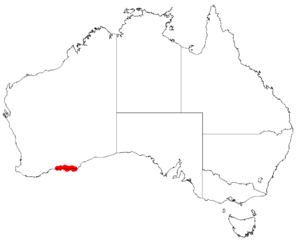Macrozamia dyeri facts for kids
Quick facts for kids Macrozamia dyeri |
|
|---|---|
 |
|
| Conservation status | |
| Scientific classification | |
| Genus: |
Macrozamia
|
| Species: |
dyeri
|
 |
|
| Occurrence data from AVH | |
The Macrozamia dyeri, also called djeeri, is a special type of plant found only in Western Australia. It grows mainly near the town of Esperance. This plant is part of the Zamiaceae family, which includes ancient plants called cycads.
While most parts of the djeeri plant are poisonous to many animals, its seeds can be eaten if they are prepared in a very specific way. For thousands of years, these seeds were a super important food source for the local people in the region.
Contents
Understanding the Djeeri Plant
The djeeri plant is a type of cycad, which looks a bit like a palm tree or a fern. It has a large trunk that grows above the ground, making it look like a small tree. Its leaves are wide and have a distinct shape. When the plant reproduces, it grows long, narrow cones.
Where Djeeri Grows
You can find djeeri growing in sandy areas near the coast. It prefers places where a type of tree called jarrah (Eucalyptus marginata) does not grow. Its natural home is limited to the eastern part of the Esperance Plains area.
Djeeri and People: A Long History
The seeds of the djeeri plant were a very important food for humans for a long time. The oldest proof of people preparing these seeds comes from a cave in Cape Le Grand National Park. Scientists found evidence there that dates back about 13,000 years!
At this ancient site, researchers discovered a special tool called a mordak. This tool was used to help remove the poisons from the outer layer of the seeds, called the sarcotesta. The seeds were then placed in a hollow space lined with leaves from another important local plant, paalaq (Xanthorrhoea platyphylla).
The seeds and their outer layers were buried for several weeks. This long process helped to remove the toxins, making them safe to eat. The food made from these seeds was called querning. Even after this careful preparation, the very center of the seeds could still contain some toxins, so people had to be careful.
Who Helps Djeeri Spread?
The places where djeeri plants grow often match up with areas where people have lived for a long time. These spots are usually close to lakes, springs, or fresh water sources found on granite rocks in the kwongan (a type of shrubland).
However, it's not just humans who help spread the djeeri seeds. Birds like the emu and mammals such as the common possum, known locally as quumarl (Trichosurus vulpecula), also play a role. These animals eat the seeds and then help spread them around.
Why Djeeri Can Be Toxic
The djeeri plant produces toxins called macrozamin and cycasin. These poisons are actually made by tiny living things called cyanobacteria. These bacteria live in the plant's special roots, which are called coralloid roots. The bacteria help the plant by taking nitrogen from the air and turning it into a form the plant can use.


